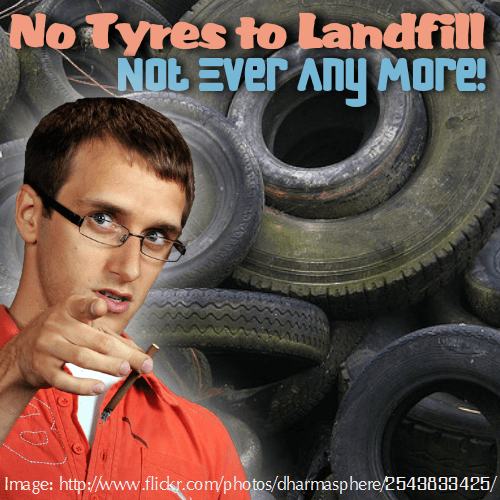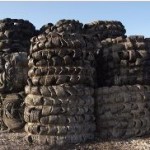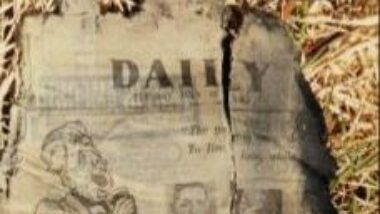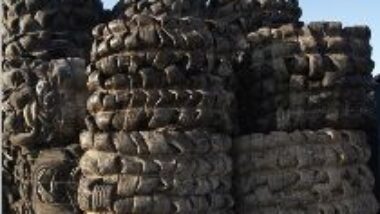This well researched article should clarify a great deal about frugal tyre use and tyre recycling.
By Ken McEvoy (written in 2005)
Under European Law it is no longer possible to dump car tyres into landfill sites which means we have to find a solution to the problem of what to do with old tyres when they have reached the end of their life. According to the Lets Recycle website, there were nearly half a million tonnes of waste tyres generated in 2004 and more than half of these were either recycled or reused, some 15% were also used as fuel, 7% exported and 6% used in landfill construction. However, nearly 59000 tonnes still ended up in landfill which was a waste of a resource, a fire hazard, and a threat to the environment. As more and more people become car owners, the problem of what to do with used tyres is set to continue.
 Tyres are classified as ‘controlled waste' so there is a Duty of Care placed on waste producers to dispose of old tyres responsibly and in an environmentally friendly way. Tyre recycling began in earnest when the EU landfill directive banned the dumping of whole used tyres in 2003, and now even shredded tyres cannot be deposited in landfill sites. The only exceptions to this are new tyres, tyres with a diameter larger than 1400 mm and bicycle tyres, which can still be disposed of in landfill sites. One thing you as a consumer can do is to extend the life of your tyres and collectively over time this can reduce the amount of tyres being disposed of each year.
Tyres are classified as ‘controlled waste' so there is a Duty of Care placed on waste producers to dispose of old tyres responsibly and in an environmentally friendly way. Tyre recycling began in earnest when the EU landfill directive banned the dumping of whole used tyres in 2003, and now even shredded tyres cannot be deposited in landfill sites. The only exceptions to this are new tyres, tyres with a diameter larger than 1400 mm and bicycle tyres, which can still be disposed of in landfill sites. One thing you as a consumer can do is to extend the life of your tyres and collectively over time this can reduce the amount of tyres being disposed of each year.
Extending the life of your tyres
Having your tyres re-treaded or buying retreads is environmentally friendly, cheaper, and they are just as safe as new tyres. Since January 2004, it is mandatory for all re-treaded tyres to be manufactured to ECE regulations and for retread producers to be licensed. However, in order to have your tyres retread they have to be kept in good condition as they can only be retread if the tread hasn't worn down too much.
Keeping your tyres in good condition not only extends the life of your tyres and reduces the number of tyres that need to be disposed of, it is also safer. Protect your tyres by driving at sensible speeds and avoid unnecessary acceleration and braking. Far less oil is used to retread a tyre than to make a new tyre, (approximately 4.5 gallons less on a passenger car) so energy and natural resources are saved in the process.
Tyre Disposal
The Tyre Recovery Association (TRA) was set up in 2004 and operates a responsible recycler scheme which aims to ensure that all their members dispose of tyres in a way that is environmentally friendly. This could mean recycling them, reprocessing them or finding another use for them. Most tyre retailers are using registered members of the TRA to collect and dispose of their old tyres and will often display a certificate so that you can be sure they are dealing with old tyres responsibly, however, if you don't know for sure just ask them.
Although most tyres are disposed of properly by responsible citizens, there are still some people who choose to dump their tyres illegally in the countryside, particularly as the removal and disposal of old tyres usually involves a small fee. Dumping tyres illegally is not only harmful to the environment; it is also unfair on the others who choose to dispose of their old tyres in the proper manner.
What happens to old tyres?
There are many ways that old tyres can be disposed of responsibly by tyre recycling, and these include the following:
Landfill Construction
- Tyres can be used as part of a Leachate draining system in landfill sites, although only a relatively small number of tyres are used for this purpose out of the millions that are scrapped each year. Tyres used in this way are exempt from landfill tax.
Reprocessed
- When tyres are ground down or shredded into small granulated bits or ‘crumbs' they can be used for a variety of different purposes such as surfacing for sports and play areas, underlay for carpets, soles for shoes and even for road construction.
Fuel
- Old tyres can replace some of the coal used to fuel cement kilns but stringent air emission limits apply to this type of operation
Serving another purpose
Tyres can also be given a second life by serving another purpose including as play items in children's play areas, motorway embankments, crash barriers at racing tracks, noise insulation, containers for compost heaps, protection for shrubs and trees and so on, the possible uses are limited only by the imagination.
Exported
Some tyres are exported to meet foreign demand for retread operations.
Conclusion
If you wish to do some of your own tyre recycling, dispose of old or unwanted tyres, contact your local tyre retailer who may be able to arrange collection and disposal for a small fee. You could also contact www.tyrerecovery.org.uk for more information. Alternatively, you could find another use for them yourself as a child's swing perhaps or as protection for plants in your garden. Don't tip on the fly, act responsibly and contribute to a greener environment.
Other pages readers of this Tyre Recycling page have found interesting are:
Use BAS 108 Tyre Bales for ultimate economy and sustainability
Tyres and Landfill
Dave McEvoy is a UK skip hire expert. For more information about skip hire in Birmingham, please visit Value Skips.
Advantages of BSI PAS 108 Tyre Bales: A New Sustainable Use for a Problem Waste
Every now and again, an idea comes along that seems so obvious that you wonder why nobody thought of it before, and the BSI PAS 108: Specification for production of tyre bales for use in construction is one of those. This simple act should revolutionise the use of tyre bales in civil engineering and landscape applications, […]






